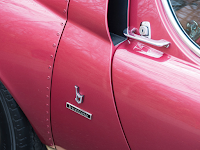The Lamborghini Miura is a sports car that was produced by Italian automaker Lamborghini between 1966 and 1973. The car is widely considered to have instigated the trend of high performance, two-seater, mid-engined sports cars. When released, it was the fastest production road car available.
As Lamborghini's flagship car, the Miura remained in production until 1973 until the Countach entered production in 1974. The early Miura model, known as the P400 (for Posteriore 4 litri), was powered by a version of the 3.9 L Lamborghini V12 engine, mounted transversely and producing 350 PS (260 kW; 350 hp). Exactly 275 units of the P400 were produced between 1966 and 1969.
Introduced in 1968, the P400S Miura, also known as the Miura S, was slightly revised from the P400, with the addition of power windows, bright chrome trim around external windows and headlights, new overhead inline console with new rocker switches, engine intake manifolds made 2mm larger, different camshaft profiles, and notched trunk end panels (allowing for slightly more luggage space). Engine changes were reportedly good for an additional 20 PS (15 kW; 20 hp). A total of 338 different P400S versions were completed.
The last and most famous Miura, the P400SV or Miura SV featured different cam timing and altered carburetors. These gave the engine an additional 15 PS (11 kW; 15 hp), to 385 PS (283 kW; 380 hp). Only 150 Miura SV models were completed.
The last and most famous Miura, the P400SV or Miura SV featured different cam timing and altered carburetors. These gave the engine an additional 15 PS (11 kW; 15 hp), to 385 PS (283 kW; 380 hp). Only 150 Miura SV models were completed.
In 1970, Lamborghini development driver Bob Wallace created a test mule that would conform to the FIA's Appendix J (touring cars) racing regulations. The car was appropriately named the Miura Jota (the pronunciation of the letter 'J' in Spanish). Wallace made extensive modifications to the standard Miura chassis and engine. Weight reductions included replacing steel chassis components and body panels with the lightweight aluminium alloy Avional and replacing side windows with plastic, with the resulting car weighing approximately 800 pounds less than a production Miura. It was destroyed in a fire in 1974. (wikipedia)
There is also one Miura SVR: a race car evolution of the fabled Jota developed by Bob Wallace, which was even featured in the Japanese manga 'Circuit Wolf'. After Wallace's Jota was lost in an accident, incessant customer demand in the following years led Automobili Lamborghini to build a few Miura SVJ models and - remarkably - a single Miura SVR. The latter was eventually sold in Japan, where it served as the 'model' for both the vehicle used in the comic book and the Kyosho toy version. The car is the Miura SVR chassis number #3781. (conceptcarz.com)
There is also one Miura SVR: a race car evolution of the fabled Jota developed by Bob Wallace, which was even featured in the Japanese manga 'Circuit Wolf'. After Wallace's Jota was lost in an accident, incessant customer demand in the following years led Automobili Lamborghini to build a few Miura SVJ models and - remarkably - a single Miura SVR. The latter was eventually sold in Japan, where it served as the 'model' for both the vehicle used in the comic book and the Kyosho toy version. The car is the Miura SVR chassis number #3781. (conceptcarz.com)
Miura P400 SV/J
Requested by customers for Jota-like options, Lamborghini obliged and six cars, sometimes called Miura SVJs, powered by naturally aspired V12 engines that produced 440 bhp @ 8500 rpm. Cosmetically, they mimicked the performance of Bob's original. Unlike the original, these customer cars had some interior comforts, but kept the purposeful body modifications and engine tuning. They also had suspension, exhaust and brake cooling upgrades.
Currently around sixteen Miuras have been upgraded to reflect the performance and styling of the original Jota. Of these, only chassis #4860, #4892, #4990, #4934, #5100/4956, #5090 were sold with original factory upgrades. The other ten or so cars were officially updated later by Lamborghini or by Wallace himself.
Chassis # 4892
One of the factory-modified cars. Sold for €832,176 ($1.1M) in an auction in 2010.
Chassis #5090
Chassis # 4934
Originally ordered by the Shah of Iran as one of his many Miuras, this car was seized in 1995 and eventually auctioned to Nicolas Cage for $490,000 USD. #4394 has since been sold to a collector in the UK and has 4,800km on the odometer. (supercars.net)
(Photos from autowp.ru, supercars.net & rmauctions.com)












































































